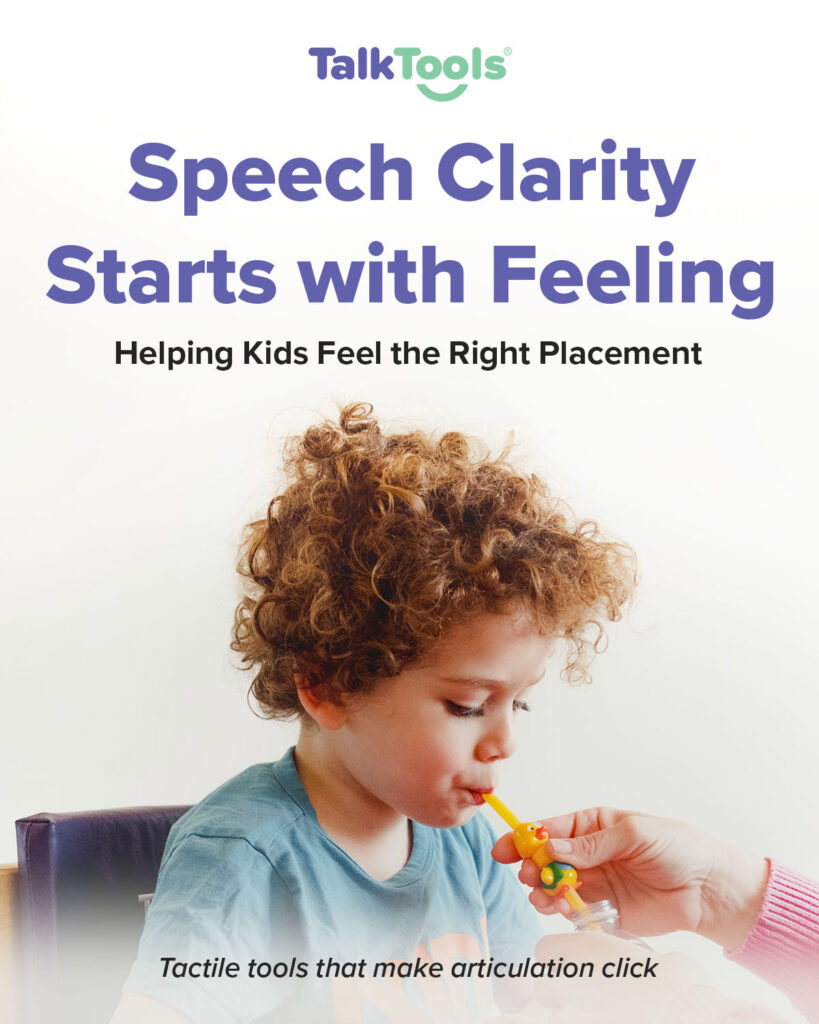
Clear speech isn’t learned by listening alone—it’s learned by feeling accurate movements. That’s why many clinicians use speech therapy tools for speech clarity to give kids precise, repeatable tactile cues for tongue, lip, and jaw placement. When children can feel the target, they build motor memory that turns accurate practice into confident speech. (ASHA overview on speech sound disorders, articulation & phonology).
Why tactile placement helps articulation
- Precision: Children experience where the tongue should land (e.g., the “spot” behind the upper teeth), reducing guessing.
- Stability: A calm, steady jaw frees the tongue and lips to make fine, accurate movements.
- Consistency: Repeated tactile-kinesthetic cues become motor patterns that carry into words and sentences (aligned with motor learning principles).
Who benefits
Children who:
- Substitute sounds (e.g., “wabbit” for “rabbit”)
- Distort sibilants (frontal or lateral lisps)
- Lose placement during rapid speech
- Need extra jaw stability to support accurate tongue movements
From placement to production (a simple therapy flow)
- Prime the placement. Brief tactile cues help the child feel where the sound lives (e.g., tongue to alveolar ridge for /t, d, n, l/).
- Say it right away. Produce the target sound immediately after the cue (isolation → syllables like “ta, tee, toe”).
- Build into words. Pair the movement with real words and short phrases (“sun, soup, soccer” for /s/).
- Carry into conversation. Use quick, playful prompts in daily routines to keep accuracy as speech speeds up.
Subtle supports clinicians often reach for
- Oral placement tools to provide a tactile “target” so the child can locate—and hold—correct placement (overview: Oral Placement Therapy).
- Tongue tip tools when the tip needs a clear landing zone for alveolar sounds (see Tongue Tip Tool Set).
- Articulation picture cards that connect the correct oral movement to specific sounds, then step into words and phrases (OPT-S Articulation Card Set).
- Bite blocks when a steadier jaw would unlock better tongue precision for crisp sounds (Jaw Grading Bite Blocks).
Example cues by sound family
- Alveolars (/t, d, n, l/): Cue tongue to the ridge; produce “ta/tee/toe,” then words.
- Sibilants (/s, z/): Cue a centered tongue groove and steady airflow; move to “see/so/sue,” then phrases.
- Palato-alveolars (/sh, ch, j/): Slight tongue retraction with gentle lip rounding; shape into target syllables.
Practice that sticks (quick tips)
- Keep drills short and frequent; start with success and stop before fatigue.
- Transition from tools to natural speech as soon as accuracy is stable.
- Fold targets into games, choices, and stories so new motor patterns show up in everyday talking.
Want to go deeper?
- Foundations & course pathway: 3-Part Treatment Plan for OPT™ and OPT™: Assessment & Program Plan Development.
- Core text clinicians reference: OPT for Speech Clarity and Feeding (book).
- Evidence context to inform practice: ASHA’s Practice Portal on Speech Sound Disorders: Articulation & Phonology and the motor-learning tutorial by Maas et al. (2008).
Helping a child find clearer speech takes patience—and the right kind of feedback. With tactile cues, supportive tools, and professional guidance, practice becomes more accurate, less frustrating, and easier to carry into real-life talking.
Disclaimer: TalkTools® products and training are intended for use by, or under the guidance of, qualified speech or feeding therapists. Parents and caregivers should consult a licensed professional to ensure exercises are safe, appropriate, and tailored to the child’s needs. Tools support therapy goals and do not replace professional evaluation or treatment.